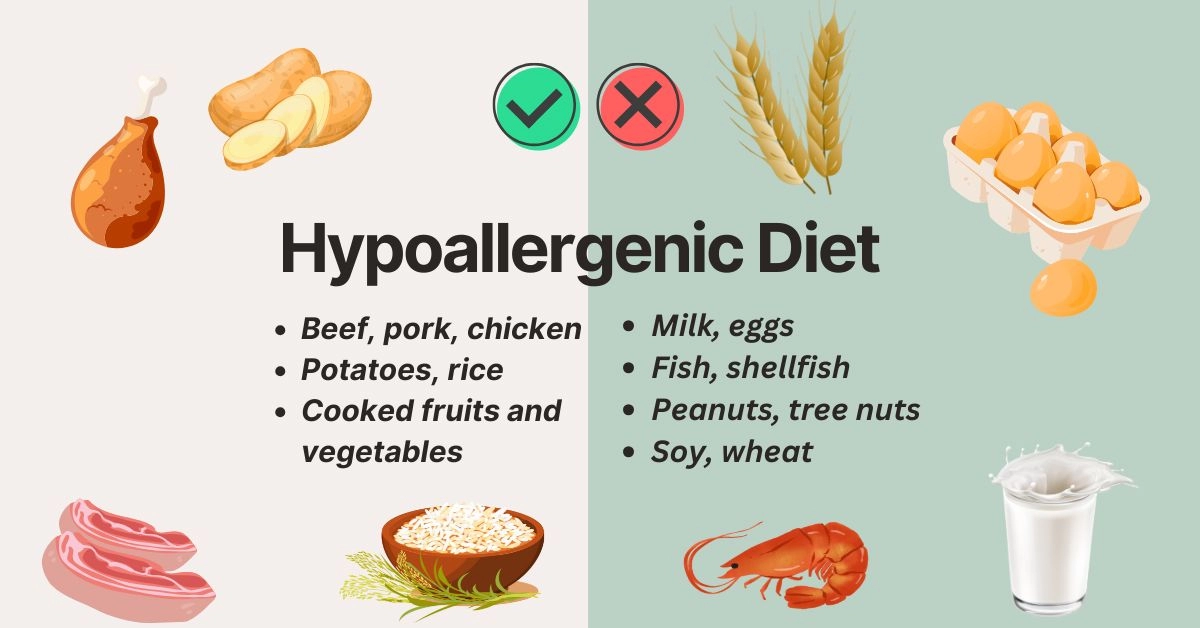Hypoallergenic Diet — Foods to Eat and Foods to Avoid

Introduction
A hypoallergenic diet is designed to reduce or eliminate foods known to cause allergic reactions. This type of diet is often used to identify food allergies or sensitivities, manage symptoms, and improve overall health.
What is a Hypoallergenic Diet?
A hypoallergenic diet is a dietary approach aimed at reducing or eliminating foods that trigger allergic reactions. It also helps identify which specific foods may be causing these reactions. This diet does not have strict and exact rules but rather general guidelines (1).
A hypoallergenic diet generally involves two main phases: the elimination phase and the reintroduction phase. The initial stage requires removing all potential allergenic foods from your diet. It’s important to follow this phase strictly for a period of 2 to 6 weeks.
The reintroduction phase involves gradually adding one food at a time to the diet, observing for allergic reactions or symptoms, and allowing several days between testing each new food to determine any potential sensitivities accurately.
Dietary interventions benefit from targeting underlying causes rather than just alleviating symptoms. However, there are potential risks if these dietary changes lead to deficiencies in essential nutrients like calories, protein, or minerals such as calcium. In children, avoiding multiple foods can be particularly risky and necessitates ongoing dietary supervision to ensure proper nutrition (2).
Foods to Avoid on a Hypoallergenic Diet
While almost any food has the potential to cause an allergic reaction, nine specific foods are responsible for the majority of such reactions (3). To follow a hypoallergenic diet effectively, it is crucial to avoid not only these nine major allergenic foods but also any products that may contain these foods or their derivatives.
- Cow’s milk
- Eggs
- Peanuts
- Soy and soy products, such as edamame, miso, natto, shoyu, tempeh, soy sauce, tofu, etc.
- Wheat and wheat products, such as bread, bulgur, couscous, durum, farina, flour, pasta, semolina, spelt, etc.
- Tree nuts, including walnuts, almonds, hazelnuts, cashews and Brazil nuts
- Shellfish, including crustaceans, such as shrimps, prawns, crab, and lobster, and mollusks or bivalves, such as clams, oysters, octopus, squid, and abalone.
- Fish, especially salmon, tuna, catfish, and cod
- Sesame, including halva, tahini
These allergens make up about 85% of all food allergies (4).
Baked or extensively heated cow’s milk is less allergenic than fresh milk. Well-cooked eggs are also better tolerated by people with an egg allergy.
Nickel is a common allergen found in various foods, including oatmeal, beans, peas, soybeans, shellfish, and chocolate (4).
Avoiding citrus fruits is also recommended.
Foods to Eat on a Hypoallergenic Diet
Naturally, a hypoallergenic diet is free from the aforementioned foods; however, it is also important to avoid nutritional deficiencies.
During a hypoallergenic diet, it is recommended to consume gluten-free foods rice, beef, chicken meat, vegetables, and fruits, but only after cooking. Parsley and seasonings are to be avoided. For beverages, it is advised to drink only drinking water, mineral water, and black tea (5).
While fresh and unprocessed meat is allowed, processed or seasoned meats may exacerbate the condition.
Scientifically speaking, hypoallergenic foods are those in which the primary immunoglobulin E (IgE)-binding allergens are either absent or significantly reduced (6).
Hypoallergenic Diet and Atopic Dermatitis
One study evaluated the effectiveness of a hypoallergenic diet in treating atopic dermatitis in adults. The results showed that this diet significantly improved dermatitis symptoms, such as reducing redness, swelling, itching, crusting, excoriations, and sleeplessness, for many participants (2, 5).
The diet was additive-free and low in biogenic amines. It involved eliminating fresh fruit, vegetables, soy, and nuts, which could act as cross allergens. This short-term diagnostic should be used only as a temporary measure before conducting challenge tests in patients with severe and moderate forms of atopic dermatitis.
Summary
A hypoallergenic diet aims to reduce or eliminate foods that trigger allergic reactions and helps identify specific food allergens. It follows general guidelines rather than strict rules and typically involves two phases: elimination and reintroduction.
All potential allergenic foods are removed from the diet during the elimination phase for 2 to 6 weeks. In the reintroduction phase, foods are gradually added back one at a time, with several days between each, to monitor for allergic reactions or symptoms and accurately identify sensitivities.
To effectively follow a hypoallergenic diet, it is essential to avoid the nine major allergenic foods and their derivatives: cow's milk, eggs, peanuts, soy, wheat, tree nuts, shellfish, fish, and sesame.
A hypoallergenic diet typically includes gluten-free foods, potatoes, rice, beef, pork, chicken, vegetables, and fruits, but only after they have been cooked and preferably peeled. Parsley, celery, and seasonings are usually avoided. Recommended beverages are drinking water, mineral water, and black tea.
Research on the effectiveness of a hypoallergenic diet in treating atopic dermatitis in adults found significant improvement in symptoms such as redness, swelling, itching, crusting, excoriations, and sleeplessness.
References
- https://www.researchgate.net/publication/236046859
- https://www.ncbi.nlm.nih.gov/pmc/articles/PMC3519248/
- https://www.foodallergy.org/living-food-allergies/food-allergy-essentials/common-allergens
- https://pds.org.ph/hypoallergenic-diet-in-dermatology/
- https://www.ncbi.nlm.nih.gov/pmc/articles/PMC3667293/
- https://www.researchgate.net/publication/316785270
